 Italian Regia Marina, 1874-1900
Italian Regia Marina, 1874-1900
Too late for the war with Austria: The Principe Amedeo class the last ironclad warships built for the Italian Regia Marina and the culmination of and the major naval construction program created in the wake of Italian unification. Principe Amedeo and Palestro however were ordered in August 1965, prior to the 3rd unification war, and were not completed in time to see action. Instead, these last ships with sailing rigs and wooden hulls, sporting a battery of six 254 mm (10 in) guns and capable of 12 knots (22 km/h; 14 mph). had uneventful careers in the Italian colonial empire. From the 1880s they were cast in secondary roles, headquarters ships and harbor defense vessels, Principe Amedeo ending as a depot ship in 1895, stricken 1910, her sister Palestro as training ship until 1900 and scrapped from 1902.
The Austro-Italian ironclad arms race
⚙ The Austro-Italian naval Arms Race prior to Lissa (1864) | |
 Regia Marina Regia Marina |  KuK Kriegsmarine KuK Kriegsmarine |
|
Formidabile class 1860 Principe di Carignano class 1861 Re d'Italia class 1861 Regina Maria Pia class (1862) Roma class (1863) Affondatore (1863) Principe Amedeo class (ordered 1865) |
Drache class (1860) Kaiser Max class (1861) Erzherzog Ferdinand Max class (1863) |
The first Italian composite hulled Ironclads
A last class of “classic” ironclads was planned on 1862 under Prime Minister Urbano Rattazzi and naval minister (later fleet admiral) Carlo Pellion di Persano. Together they agreed to create a powerful fleet of ironclad warships that could deter any Austrian claim in the Adriatic and show the flag, potentially bombard the coast and bring a massive advantage on the bargaining table. The Regia Marina started to acquire two French-built armored frigates, the Formidabile class, the two Re d’Italia from the United States and ordered five more abroad due to the limited capabilities and skills of Italian yards for ironclads at the time, with three wooden steam frigates under construction locally being converted into armored ships, four more ironclads ordered from Italian shipyards at last. The first pair was completed soon enough to see action at Lissa, but the last two, the Principe Amedeo-class were the last representants of this first generation of Italian ironclads.
Their design was prepared by Inspector Engineer Giuseppe De Luca, which initially planned for them fully wooden hulls, but recent advances made in British naval construction notably convinced him to swap for a composite wood and iron (the internal structure, keel, ribs and transverse beams) construction just prior to lay them down, with the yard chosen being the most capable, Regio Cantiere di Castellammare di Stabia for Amedeo and Arsenale di La Spezia for Palestro. Both were ordered in August 1865 (date not precised) and thus authors are split on the class name, some calling them the “Palestro class” based on the launching date, others the Principe de Amedeo class based on completion date, as the last was “quicker” to built, in almost 3 years from launch (Jan 72 to Dec. 74) and the other from Oct. 71 to July 74 (more than 4 years). In fact construction was ongoing during the war in 1866, and suspended at the end of the war as there was no longer the need for them. It took some persuasion in the parliament to finance their completion, when construction resumed in 1869. Ten years were an issue for wooden ships as the wood aged more or less well, and reduced their service time depending on its storage and treatment. In that case however, the structure was all iron, reducing some risks.
But their useful career was short, about ten years while being obsolete at completion, and versed to other roles. They were not bad ships, just victims of circumstances.
Design of the class
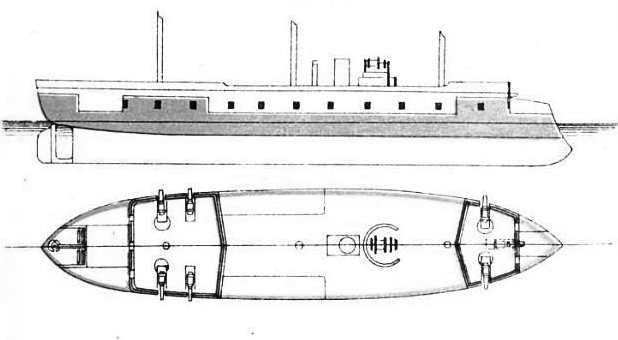
Hull and general design
The two ships were ordered at the same time and yet had slightly diverging hulls based on the same initial specs, which often was an outcome when built in different yards: The two ships differed slightly in size with Principe Amedeo reaching 79.73 meters (261 ft 7 in) long between perpendiculars, Palestro 78.82 m (258 ft 7 in) so shorter.
Principe Amedeo was a bit beamier at 17.4 m (57 ft 1 in) but less draftier at 7.9 m (25 ft 11 in) fully loaded whereas Palestro was 17.3 m (56 ft 9 in) in beam and draftier at 8 m (26 ft 3 in). Both ships had the same calculated standard displacement of 5,761 long tons (5,853 t), but Principe Amedeo was noted as 6,020 long tons (6,120 t) fully loaded and Palestro reached 6,318 long tons (3,419 t).
Both had a reinforced inverted bow and naval ram below the waterline as well as minimalistic superstructure with a small conning tower forward of the single funnel and a flying bridge built atop for the captain and staff. The crew consisted of 548 officers and ratings.
Protection
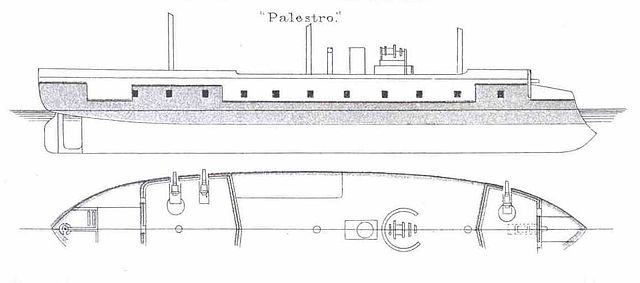
This was a classic sandwich of compound iron plating for the full lenght belt, backed by teak, which was classic at the time.
Belt armor: 221 mm (8.7 in)
Casemate: 140 mm (5.5 in) protecting the main guns forward and aft, the central battery section was unprotected.
Conning tower: 61 mm (2.4 in) walls. It was large enough for the coxwain and captain plus staff to stand inside.
Powerplant
The class had a single-expansion steam engine driving a single screw propeller, while steam came from six coal-fired cylindrical fire-tube boilers, exhausted through a truncated single funnel directly aft of the conning tower. Top speed was a real progress compared to previous Italian-built ironclads at 12.2 knots (22.6 km/h; 14.0 mph)based on 6,117 indicated horsepower (4,561 kW). The stam range was 1,780 nautical miles (3,300 km; 2,050 mi) at 10 knots (19 km/h; 12 mph) based on their coal reserve, and unlimited when using the full rigging. They were indeed barque-rigged with three masts (three sail stages, course, topsail, topgallant) a bowsprit with two main jibs and a spanker and gaff topsail on the mizzenmast. They were the last rigged ironclads built by Italy. The Affondatore built in Britain which arrived just in time for the battle of Lissa, had indeed a much reduced rig.
Armament
The interesting part of the design was their peculiar armament, as both as designed were armed with a main battery of six 254 mm (10 in) guns. They were mounted differently in each ship however. Principe Amedeo had all guns in a single armored casemate amidships. Palestro had them mounted instead in three armored casemates, one forward toward the bow, and second and third close to the stern on eiher side. Both had also a single 279 mm (11 in) gun forward as bow chaser. In the 1880s, Principe Amedeo received six 74 mm (2.9 in) guns, six machine guns, two torpedo tubes. It’s not sure about her sister Palestro.
⚙ specifications |
|
| Displacement | 5,761 long tons normal, 6,318 long tons FL |
| Dimensions | 78.82 x 17.3 x 8 m(258 ft 7 in x 56 ft 9 in x 26 ft 3 in) |
| Propulsion | 1 screw propeller driven by a marine steam engine, 6 fire-tube boilers: 6,117 ihp (4,561 kW) |
| Speed | 12.85 knots (23.80 km/h; 14.79 mph) |
| Range | 1,780 nmi (3,300 km) at 10 kn (19 km/h; 12 mph) |
| Armament | 6 × 254 mm (10 in) guns, 1 × 279 mm (11 in) bow gun |
| Protection | Belt 221 mm (8.7 in), Casemate 140 mm (5.5 in), CT 61 mm (2.4 in) |
| Crew | 548 |
General Assessement
Although these were the first battleships entirely designed and built in Italy, and first with casemates and composite hulls, they left less impression than for example the 1879 Duilio class ironclads. Both ship had eventless career, being completed “after the show” after being delayed for years and compltely missing the Italian unification. As completed in 1874-75 the world had changed fast and they were already obsolete, pitted against steel-cladded casemate battleships with rail-mounted high traverse heavy guns and turret ships, even the first rig-less vessel. They were assigned to the Italian colonial empire which was less risky for their design, and occasionaly saw common fleet exercises wit the rest of the fleet; In 1880, Palestro still showed the flag off Ragusa, in an attempt to force the Ottoman Empire to comply with the Treaty of Berlin and cede Ulcinj to Montenegro. Principe Amedeo in 1881 collided with another ironclad, Roma, during a hurricane, but damage was minimal.
By the late 1880s both were seen as completeluy obsolete and retired from frontline service, taking harbour roles such as headquarters ships in Taranto for Principe Amedeo, La Maddalena for Palestro. Principe Amedeo was stricken first, in 1895 stripped and converted as ammunition depot ship in Taranto, staying there until sold for scrapin 1910. Her sister Palestro was used as training ship between 1894 and 1900 until stricken that same year and brsold for BU, broken up between 1902 and 1904.
 Principe Amedeo (1872)
Principe Amedeo (1872)
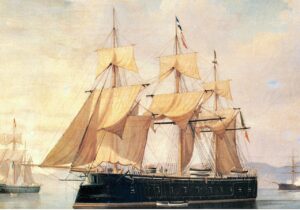 Principe Amedeo emerged from the Regio Cantiere di Castellammare di Stabia for a slow fitting-out work, completed 15 December 1874, performed at Arsenale di La Spezia. She was Obsolescent at the time and not included in the main fleet, instead she was assigned to the fledging Italian colonial empire fom the 1880s. She was called for a few training maneuvers with the main Italian fleet however at least until 1885. On 25 June 1879 she collided with the steamship “Mediteranee off Riposto”. Both were damaged and Principe Amedeo sailed to Naples under her own power for repairs. She was also present at the launching ceremony for the brand new and massive battleship “Italia” on 29 September 1880 with her earlier sister Regina Maria Pia making a gun salute for King Umberto I preent that day aboard his yacht, as were the British ironclads HMS Monarch and Thunderer, Vice Admiral George Tryon at the head of the Mediterranean Fleet. Principe Amedeo was flagship for Vice Admiral Martini that day. By early November 1881, Principe Amedeo was caught in a severe storm in Naples and albeit moored, she was near-rammed by Roma, further at sea, which tore free from her anchors, went free until knocking the flank of Principe Amedeo. At the speed it happened, dazmage however was minimal.
Principe Amedeo emerged from the Regio Cantiere di Castellammare di Stabia for a slow fitting-out work, completed 15 December 1874, performed at Arsenale di La Spezia. She was Obsolescent at the time and not included in the main fleet, instead she was assigned to the fledging Italian colonial empire fom the 1880s. She was called for a few training maneuvers with the main Italian fleet however at least until 1885. On 25 June 1879 she collided with the steamship “Mediteranee off Riposto”. Both were damaged and Principe Amedeo sailed to Naples under her own power for repairs. She was also present at the launching ceremony for the brand new and massive battleship “Italia” on 29 September 1880 with her earlier sister Regina Maria Pia making a gun salute for King Umberto I preent that day aboard his yacht, as were the British ironclads HMS Monarch and Thunderer, Vice Admiral George Tryon at the head of the Mediterranean Fleet. Principe Amedeo was flagship for Vice Admiral Martini that day. By early November 1881, Principe Amedeo was caught in a severe storm in Naples and albeit moored, she was near-rammed by Roma, further at sea, which tore free from her anchors, went free until knocking the flank of Principe Amedeo. At the speed it happened, dazmage however was minimal.
She took part still in the annual fleet maneuvers of 1885, as flagship for the “Eastern Squadron” under Rear Admiral Civita, and in her fleet was the the ironclad Castelfidardo, corvette Amerigo Vespucci and a sloop as well as four early torpedo boats. It defended against the “Western Squadron” to simulate a Franco-Italian war off Sardinia. The latter was supposed to came out from Toulon, and in this scenario Principe Amedeo was forced to “surrender” to the ironclad Duilio.
From 1888 to 1889, Principe Amedeo became headquarters ship for the Taranto harbour defence fleet, including fortifications. She had been downgraded, rearmed with just six 2.9 in (74 mm) guns intended only for close-range defense, as well as six machine guns to deal with torpedo boats and two torpedo tubes. She served that way until stricken from the naval register on 28 March 1895. Next she became an ammunition depot ship, still anchored in Taranto until sold for BU in 1910.
 Palestro (1871)
Palestro (1871)
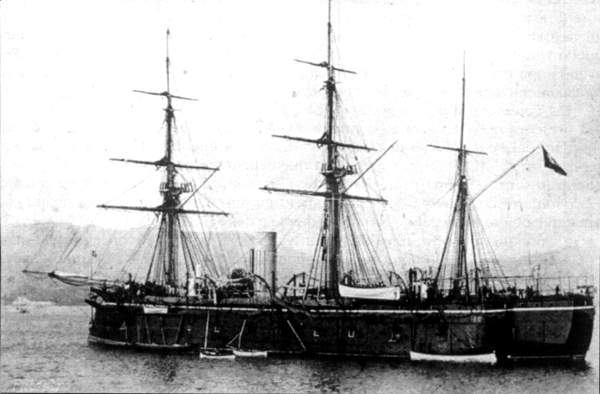
Although her initial name is not clear, she was named after being laid down after the gunboat Palestro sunk at the Battle of Lissa in 1866. The exact launch date remained foggy, some sources and historians and records showing 30 September or 2 October 1871. It’s perhaps due to a first failed launch although it is not mentioned either, and was both built, and fitted out at the Arsenale di La Spezia, officially completed on 11 July 1875, a decade old and thus Obsolescent so like her sister she was sent to defend the young Italian colonial empire, while occasionally takinh part in fleet maneuvers at several occasions.
On 14 November 1880 was there to assist the refloating of the P&O steamship Sumatra whiuch ran run aground at Brindisi. With the ironclad Roma she took part in a show of force off Ragusa about the Treaty of Berlin claiming Ottoman-held the city Ulcinj for Montenegro.
Palestro like her sister ended as headquarters ship in La Maddalena, directing the harbour defence forces, naval and fortifications, from 1889 to 1894. From there, she became a training ship for coxswains, presumably partially disarmed, although there are no records of this armament. She was then towed to be stationed in La Spezia in 1895 and became a “special service ship” until stricken on 14 April 1900, sold in 1092 and broken up between 1902 and 1904 like her sister.
Read More/Src
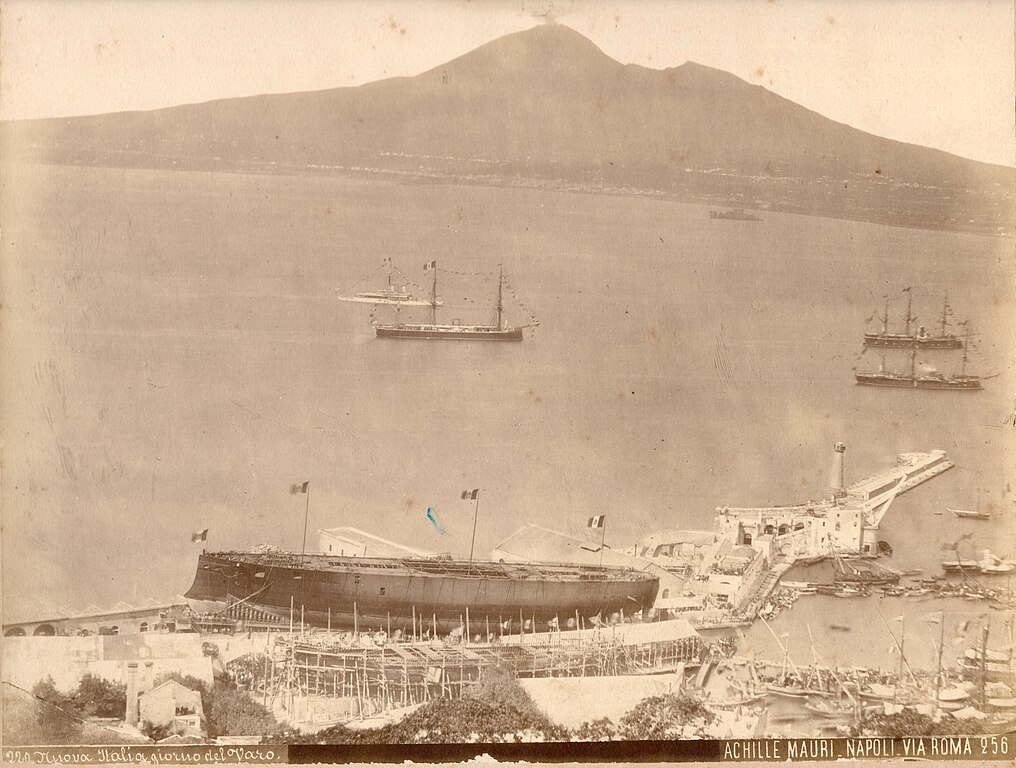
The Italian battleship Italia taken the day of the launch at Cantiere navale di Castellammare di Stabia on September 29, 1880. Principe Amedeo (right background) at the launch for the ironclad Italia in 1880. The other ships present are the Italian Regina Maria Pia (in front of Principe Amedeo) and the British HMS Monarch and Thunderer. photo 1880-09-29, scan from own private archive, photo by Achille Mauri, scan by Paola and Massimo Carlesi
Books
Brassey, Thomas, ed. (1886). “Evolutions of the Italian Navy, 1885”. The Naval Annual. Portsmouth: J. Griffin & Co
Clowes, W. Laird (1905). The Naval Pocket-Book. London: W. Thacker & Co.
Fitzgerald, Charles (1897). Life of Vice-Admiral Sir George Tryon, K.C.B. London: William Blackwood and Sons.
Fraccaroli, Aldo (1979). “Italy”. In Gardiner, Robert (ed.). Conway’s All the World’s Fighting Ships 1860–1905.
Ordovini, Aldo F.; Petronio, Fulvio & Sullivan, David M. (December 2014). “Capital Ships of the Royal Italian Navy, 1860–1918 Part I.
Pakenham, Thomas (1992). The Scramble for Africa: White Man’s Conquest of the Dark Continent from 1876 to 1912. New York: Perennial.
Links
marina.difesa.it/
agenziabozzo.it/
web.archive.org/
digilander.libero.it/
web.archive.org/
web.archive.org/
en.wikipedia.org/
Model Kits
None


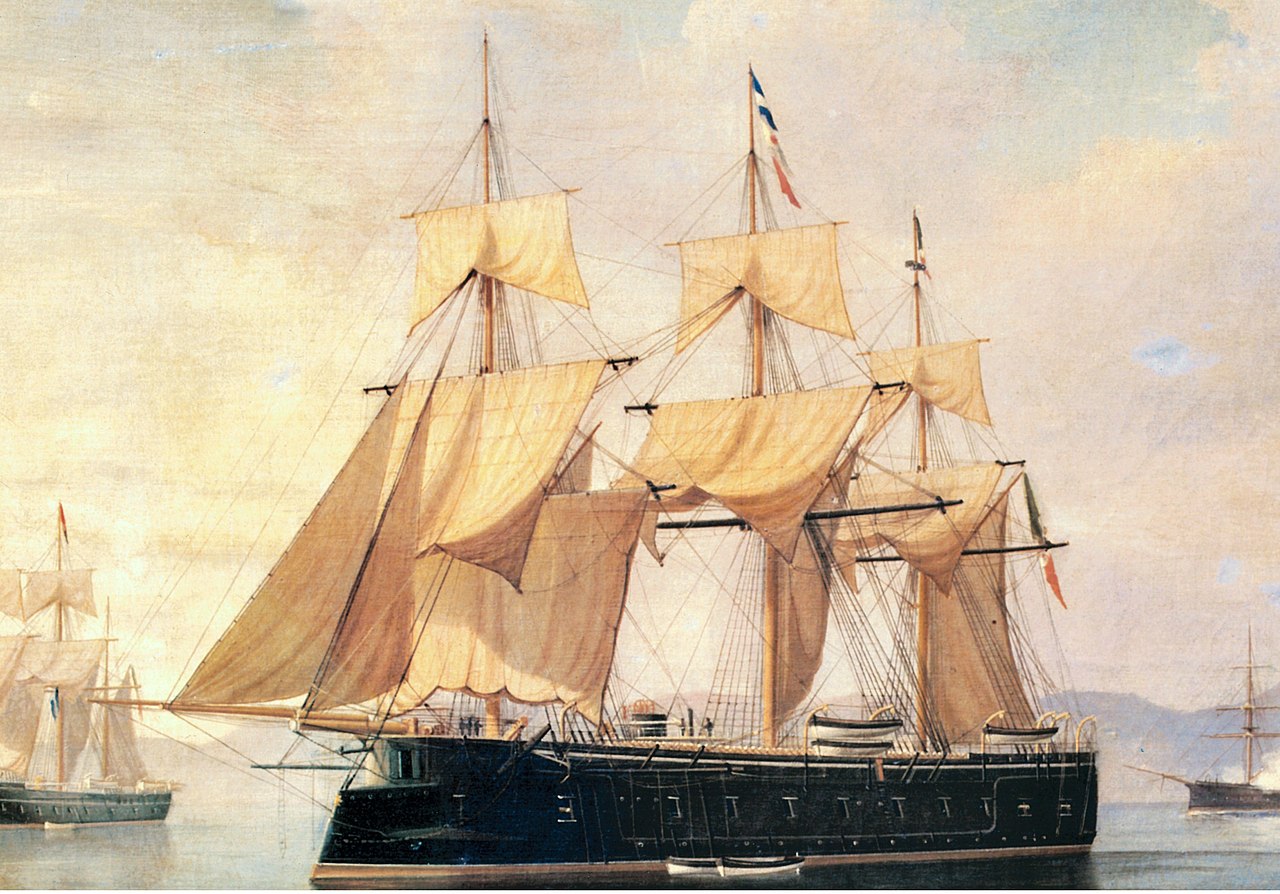
 Latest Facebook Entry -
Latest Facebook Entry -  X(Tweeter) Naval Encyclopedia's deck archive
X(Tweeter) Naval Encyclopedia's deck archive Instagram (@navalencyc)
Instagram (@navalencyc)





 French Navy
French Navy Royal Navy
Royal Navy Russian Navy
Russian Navy Armada Espanola
Armada Espanola Austrian Navy
Austrian Navy K.u.K. Kriegsmarine
K.u.K. Kriegsmarine Dansk Marine
Dansk Marine Nautiko Hellenon
Nautiko Hellenon Koninklije Marine 1870
Koninklije Marine 1870 Marinha do Brasil
Marinha do Brasil Osmanlı Donanması
Osmanlı Donanması Marina Do Peru
Marina Do Peru Marinha do Portugal
Marinha do Portugal Regia Marina 1870
Regia Marina 1870 Nihhon Kaigun 1870
Nihhon Kaigun 1870 Preußische Marine 1870
Preußische Marine 1870 Russkiy Flot 1870
Russkiy Flot 1870 Svenska marinen
Svenska marinen Søværnet
Søværnet Union Navy
Union Navy Confederate Navy
Confederate Navy Armada de Argentina
Armada de Argentina Imperial Chinese Navy
Imperial Chinese Navy Marinha do Portugal
Marinha do Portugal Mexico
Mexico Kaiserliche Marine
Kaiserliche Marine 1898 US Navy
1898 US Navy Sovietskiy Flot
Sovietskiy Flot Royal Canadian Navy
Royal Canadian Navy Royal Australian Navy
Royal Australian Navy RNZN Fleet
RNZN Fleet Chinese Navy 1937
Chinese Navy 1937 Kriegsmarine
Kriegsmarine Chilean Navy
Chilean Navy Danish Navy
Danish Navy Finnish Navy
Finnish Navy Hellenic Navy
Hellenic Navy Polish Navy
Polish Navy Romanian Navy
Romanian Navy Turkish Navy
Turkish Navy Royal Yugoslav Navy
Royal Yugoslav Navy Royal Thai Navy
Royal Thai Navy Minor Navies
Minor Navies Albania
Albania Austria
Austria Belgium
Belgium Columbia
Columbia Costa Rica
Costa Rica Cuba
Cuba Czechoslovakia
Czechoslovakia Dominican Republic
Dominican Republic Haiti
Haiti Hungary
Hungary Honduras
Honduras Estonia
Estonia Iceland
Iceland Eire
Eire Equador
Equador Iran
Iran Iraq
Iraq Latvia
Latvia Liberia
Liberia Lithuania
Lithuania Mandchukuo
Mandchukuo Morocco
Morocco Nicaragua
Nicaragua Persia
Persia San Salvador
San Salvador Sarawak
Sarawak Uruguay
Uruguay Venezuela
Venezuela Zanzibar
Zanzibar Warsaw Pact Navies
Warsaw Pact Navies Bulgaria
Bulgaria Hungary
Hungary

 Bundesmarine
Bundesmarine Dutch Navy
Dutch Navy Hellenic Navy
Hellenic Navy Marina Militare
Marina Militare Yugoslav Navy
Yugoslav Navy Chinese Navy
Chinese Navy Indian Navy
Indian Navy Indonesian Navy
Indonesian Navy JMSDF
JMSDF North Korean Navy
North Korean Navy Pakistani Navy
Pakistani Navy Philippines Navy
Philippines Navy ROKN
ROKN Rep. of Singapore Navy
Rep. of Singapore Navy Taiwanese Navy
Taiwanese Navy IDF Navy
IDF Navy Saudi Navy
Saudi Navy Royal New Zealand Navy
Royal New Zealand Navy Egyptian Navy
Egyptian Navy South African Navy
South African Navy






























 Ukrainian Navy
Ukrainian Navy dbodesign
dbodesign